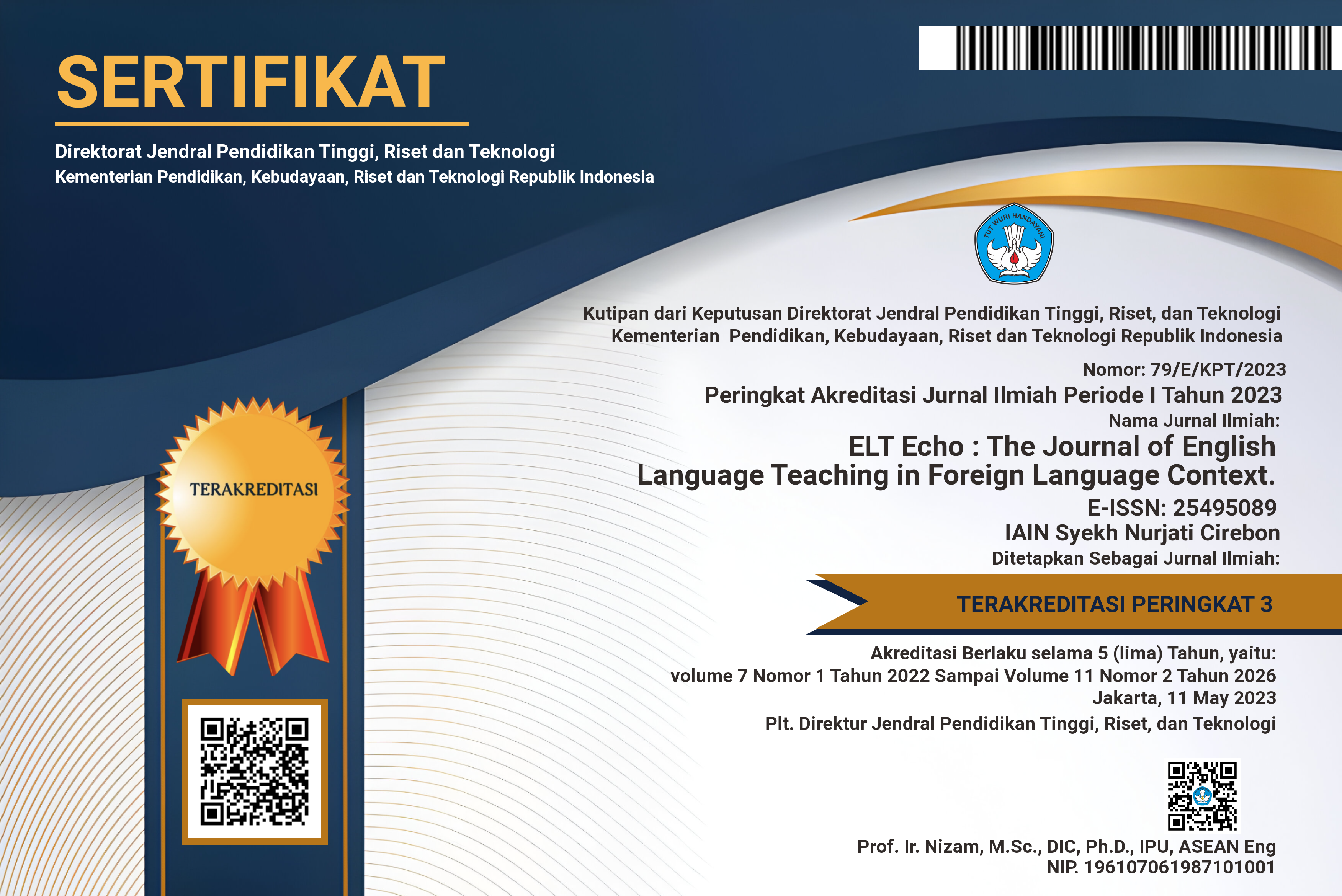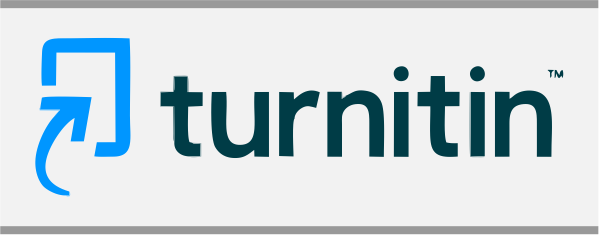THE USE OF PLOTAGON AS A CREATIVE DIGITAL MEDIA ING ENGLISH LANGUAGE TEACHING
(1) Universitas Islam Majapahit
(*) Corresponding Author
Abstract
Keywords
Full Text:
PDFReferences
Abdullah, M. R. T. L., & Siraj, S. (2014). Interpretive Structural Modeling of mLearning Curriculum Implementation Model of English Language Communication Skills for Undergraduates. Turkish Online Journal of Educational TechnologyTOJET, 13(1), 151-161.
Alivi, J. S. (2019). A review of tpack and samr models: how should language teachers adopt technology?. Journal of English for Academic and Specific Purposes (JEASP), 2(2), 1-11.
Alivi, J. S. (2022). Explaining why teachers use ICT for teaching and learning: a case study of English as a foreign language teachers in a university in Indonesia (Doctoral dissertation, University of Warwick).
Al-Khalidi, I., Hinai, O. I., & Sabah, M. A. (2022). Think, pair, and share while using Plotagon: A digital app for replacing the classroom boredom and demotivation with engagement and motivation. International Journal of English Language Education, 10(1), 1
Alwasilah, S. S. (2019). Creating your animated stories with Plotagon: Implementation of project-based learning in narrative writing. International Journal of Learning, Teaching and Educational Research, 18(12), 333-349.
Anderson, L.W., and Krathwohl, D.R. (2001). A Taxonomy for Learning, Teaching, and Assessing: A Revision of Bloom's Taxonomy. New York: Longman.
Baihaqi, M., & Ramadhani, T. F. (2023). The effectiveness of using Plotagon story media to improve listening skills for non-English speakers. Journal of English Language Studies and Teaching, 3(2), 141-150.
Bloom, B. S. (1965). Taxonomy of Educational Objectives: The Classification of Educational Goals. New York: David McKay Company.
Boholano, H. B. (2017). Smart social networking: 21st century teaching and learning skills. Research in Pedagogy, 7(1), 21-29. doi:10.17810/2015.45
Cárdenas-Robledo, L. A., & Peña-Ayala, A. (2018). Ubiquitous learning: A systematic review. Telematics and Informatics, 35(5), 1097-1132.
Chell, G., & Dowling, S. (2013). Substitution to redefinition: The challenges of using technology. Research Gate. Repéré à https://www. researchgate. net/publication/268446012_Substitution_to_Redefinition_The_Challenges_of_Using_Technology.
Cummings, C. (2014). Teacher created prescriptive interactive content (TCPIC), SAMR, and modernizing remediation in social science education. The International Society for the Social Studies Annual Conference Proceedings (Vol. 1, pp. 37-39).
Gamlo, N. H. (2014). EFL teachers use / non-use of ICT at a university in Saudi Arabia. Doctoral Thesis. University of Warwick, Coventry.
García-Sánchez, S. (2012). English in class and on the go: multimodal u-learning. The EUROCALL Review, 20(2), 94-102.
Ghamdi, K. (2015). Can an ICT CPD programme have an impact on EFL teachers in Saudi Arabia: A case study. Doctoral Thesis. Univeristy of Warwick, Coventry.
Grant, M. M. (2011). Getting a grip on project-based Learning: Theory, cases, and recommendations. Meridian: A Middle School Computer Technologies Journal, 5(1), 1-17. Retrieved from https://meridian.ced.ncsu.edu/archive/win2002/514/project-based.pdf
Green B. N., Johnson C. D., & Adams A. (2006). Writing narrative literature reviews for peer-reviewed journals: secrets of the trade. Journal of Chiropractic Medicine, 5(3):101–117. [PMC free article] [PubMed]
Guzmán Gámez, D. Y., & Moreno Cuellar, J. A. (2019). The use of Plotagon to enhance the English writing skill in secondary school students. Profile Issues in TeachersProfessional Development, 21(1), 139-153.
Harmer, J. (2015). The practice of English language teaching (5th ed.). Essex: Pearson Education Limited.
Hsu, H. Y., Wang, S. K., & Comac, L. (2008). Using audioblogs to assist English-language learning: an investigation into student perception. Computer Assisted Language Learning, 21(2), 181-198.
Jusoh, W. N. H. W., & Jusoff, K. (2009). Using multimedia in teaching Islamic studies. Journal of Media and Communication Studies, 1(5), 86.
Kurnia, F. A., Aprilia, R., Muhammad, H., & Fitriani, L. (2023). Utilization of interactive learning media based on the Plotagon application in learning English speaking skills. Akademika: Jurnal Teknologi Pendidikan, 12(02), 365-380.
Lotherington, H., & Jenson, J. (2011). Teaching multimodal and digital literacy in L2 settings: new literacies, new basics, new pedagogies. Annual Review of Applied Linguistics, 31(2011), 226-246.
Mayer, R. E. (2014). Cognitive theory of multimedia learning. In R. E. Mayer (Ed.), The Cambridge handbook of multimedia learning (pp. 43-71). Cambridge University Press.
Mishra, P., & Koehler, M. J. (2006). Technological Pedagogical Content Knowledge: A framework for teacher knowledge. Teachers College Record, 108(6), 1017-1054.
Mudinillah, A., & Nurfadilah Septika, R. (2022). Plotagon application development learning speaking skills. Al-Hijr: Journal of Adulearn World, 1(1), 16-23.
Niess, M. L. (2011). 'Investigating TPACK: Knowledge growth in teaching with technology,' J. Educational Computing Research, 44 (3) p. 299-317.
Oakley, G., & Pegrum, M. (2015). Engaging in networked learning: Innovating at the intersection of technology and pedagogy. Education Research and Perspectives, 42, 397-428.
Paré G. & Kitsiou S. (2019). Methods for literature reviews. In: Lau F, Kuziemsky C, editors. Handbook of eHealth Evaluation: An Evidence-based Approach [Internet]. Victoria (BC): University of Victoria; 2017 Feb 27. Available from: https://www.ncbi.nlm.nih.gov/books/NBK481583/
Puentedura, R. (2006). Transformation, technology, and education [Blog post]. Retrieved from http://hippasus.com/resources/tte/.
Puentedura, R. (2014). SAMR and Bloom’s Taxonomy: Assembling the Puzzle.https://www.commonsense.org/education/articles/samr-and-blooms-taxonomy - assembling-the-puzzle.
Rehman, Z. U., & Aurangzeb, W. (2021). The SAMR Model and Bloom’s Taxonomy as a framework for evaluating technology integration at university level. Global Educational Studies Review, VI, 6, 1-11.
Rienties, B., Brouwer, N., & Lygo-Baker, S. (2013). The effects of online professional development on higher education teachers’ beliefs and intentions towards learning facilitation and technology. Teaching and Teacher Education, 29(1), 122-131.
Salma, K. N., Machmudah, U., & Nurhidayati, N. (2022). Development of listening skills materials using Plotagon story application multimedia. In International Symposium on Religious Literature and Heritage (ISLAGE 2021) (pp. 70-75). Atlantis Press.
Selwyn, N. (2017). Education and technology: Key issues and debates (2nd ed.). London: Bloomsbury.
Shadiev, R., Hwang, W. Y., Ghinea, G., & Chang, M. (2018). Guest editorial: authentic edutainment with advanced technologies. Journal of Educational Technology & Society, 21(4), 111-114.
Watkins, J., & Wilkins, M. (2011). Using YouTube in the EFL classroom. Language Education in Asia, 2(1), 113-119.
DOI: 10.24235/eltecho.v9i2.19656
Article Metrics
Abstract view : 10 timesPDF - 3 times
Refbacks
- There are currently no refbacks.
Â
This Journal is indexed by:
Â

This work is licensed under a Creative Commons Attribution 4.0 International License.










